![]()
![]()
![]()
Use LEFT and RIGHT arrow keys to navigate between flashcards;
Use UP and DOWN arrow keys to flip the card;
H to show hint;
A reads text to speech;
155 Cards in this Set
- Front
- Back
|
Functions of the Digestive System |
Prehension (grabbing)/ ingestion, mechanical processing (mastication (chewing)/physical motion in the d.t.), chemical digestion, absorption of nutrients and water, elimination of wastes. |
|
|
parasympathetic (rest and digest) ; Vagus |
The digestive system is mainly under _________-control. The _____ nerve is comes into play. |
|
|
Digestive tract |
Oral cavity, pharynx (oropharynx), esophagus, stomach, small intestine (colon, cecum), large intestine (rectum, anus) |
|
|
Accessory organs of the digestive system |
Teeth and tongue, salivary glands, liver (gallbladder) pancreas. |
|
|
Vagus Nerve |
Find |
|
|
Classifications |
Based on diet (herbivores, carnivores, omnivores), and based on anatomy (mongastric (one stomach) / ruminant) |
|
|
Disgestive system |
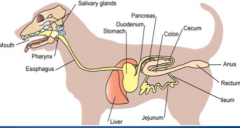
Mouth, pharynx, esophagus, salivary glands, stomach, duodenum, pancreas, liver, jejunum, colon, cecum,recum, anus, ileum. |
|
|
Oral Cavity |
Consists of lips, tongue, teeth, hard and soft palates, oropharynx, salivary glands. |
|
|
Mechanical processing and chemical digestion that begin in the mouth. |
No absorption, lips (labia) help grasp food, teeth tear and grind the food, tongue manipulates food, helps with swallowing, and have taste buds (sensory functions) |
|
|
Salivary glands in dogs and cats |
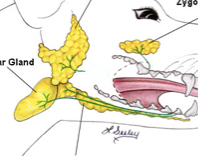
Mandibular (can see), sublingual , parotoid (can see) and zygomatic. |
|
|
Composition of saliva |
Mostly water that lubricates and flushes the oral cavity, mucin (slimy aspect) assists with lubrication, Antibodies (IgA) enzymes (amylase and ligase), and buffers including sodium bicarbonate and phosphate (important in ruminants). |
|
|
Amylase |
Enzyme in saliva that breaks down sugars and starches . Found in omnivores. |
|
|
Ligase |
Enzyme in saliva that is found in nursing animals. |
|
|
diet |
Teeth shape depend on ____ . |
|
|
Carnivore teeth |
More pointed |
|
|
Herbivore teeth |
More flat and grooved. Don't have incisors or canines. |
|
|
Brachydont |
Low-crowned teeth. Usually terminal eruptions. Omnivore and carnivore. Stay the same length |
|
|
Hypsodont |
Low crowned teeth found in herbivores. Usually erupt throughout life. |
|
|
Incisors |

Grasping teeth |
|
|
Canines |

Tearing teeth that are longer than the other teeth. |
|
|
Premolars |
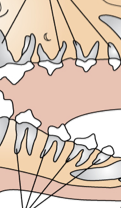
Cutting teeth that have sharp points if carnivores |
|
|
Molars |

Grinding teeth. Larger, flatter occlusal surfaces. |
|
|
Malocclusion |
Teeth that keep growing and do not grind down properly due to diet. |
|
|
Slide 8 |
Digestive |
|
|
Tooth structure (1 of 3) |
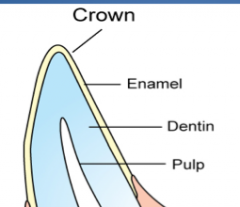
|
|
|
Tooth Structure (2 of 3) |
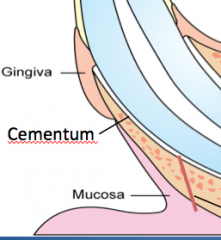
|
|
|
Tooth Structure (3 of 3) |
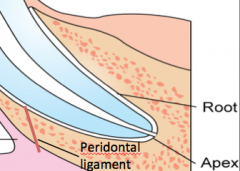
|
|
|
Pharynx ; stomach ; cardia sphincter |
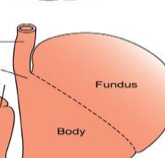
The esophagus is a muscular tube from ________ to _______ at the cardia with a ______ __________ at the entrance. |
|
|
Epithelial lining in esophagus |
Stratified squamous epithelium. Folded to allow expansion, and has submuscosal glands. |
|
|
Submuscosal glands |
Secrete mucus in the epithelial lining of the espophagus to lubricate food bolus. |
|
|
Muscle type of the esophagus |
Smooth and/or skeletal depending on the species. |
|
|
Abdomen |
Peritoneal cavity consisting of the parietal peritoneum and the visceral peritoneum. Organs are suspended from the dorsal body wall by thin sheets of connective tissue (mesenteries), and has remnants of embryonic mesentries. |
|
|
Falciform ligament |
Remnant of the embryonic mesentries in the abdomen between the liver and the abdominal wall. Anchor, hard to see. Remnant of the umbilical vessels |
|
|
Lesser omentum |
Remnant of the embryonic mesentries in the abdomen between the stomach and liver. |
|
|
Greater omentum |
Remnant of the embryonic mesentries in the abdomen that hangs from the greater curvature of the stomach and covers abdominal organs. |
|
|
See slide 12 |
Digestion |
|
|
Stomach |
Consists of the fundus and body (distensible and gastric glands (food break down)), pyloric antrum, and plyorus |
|
|
Gastric glands in the stomach |
Parietal cells (HCL and instrisnic factor), chief cells (pepsinogen, proteins to polypeptide chains, mucous cells (protect mucus) |
|
|
Gastrin secretion |
Part of the pyloric antum in the stomach. Increases HCL secretion, and promotes stomach relaxation. Promotes stomach function. |
|
|
left ; right |
The greater curvature of the stomach needs to point _____ , while the lesser curvature needs to point _____ . |
|
|
Pylorus |

Muscular sphincter of the stomach that regulates the release of chyme (digested, mixed food) into small intestine. |
|
|
Pyloric antrum |
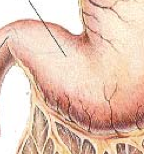
(stomach) |
|
|
Fundus (top) body (bottom) |
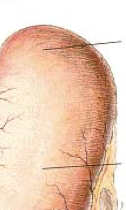
(stomach) |
|
|
Omentum |
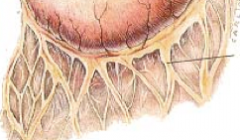
(stomach) |
|
|
Rugae |
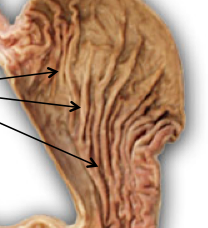
(stomach). Used for expansion to increase surface area. Darker = less secretion. |
|
|
Ruminant stomach |
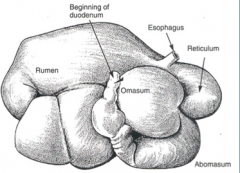
One true stomach (abomasum) consisting of three forestomachs (rumen, reticulum, omasum)
|
|
|
Rumen |
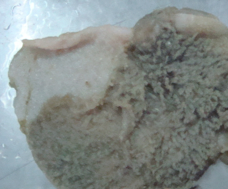
Series of muscular sacs for fermentation. Bacteria and protozoa break down and absorb cellulose and proteins. CHO and peptides are made into Volatile Fatty Acids (VFA) that's absorbed into blood, and converted into glucose and other things by the liver. Most food goes into the rumen. |
|
|
Reticulum |
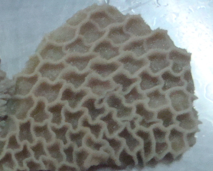
Sticks things to cells. Part of the ruminant stomach . |
|
|
Step 1 of ruminant digestion. Rumen |
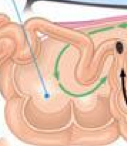
When the cow first chews and swallows a mouthful of grass, boluses (green arrows) enter the ____. |
|
|
Step 2 of ruminant digestion |
find |
|
|
Step 3 of ruminant digestion
|
find
|
|
|
Step 4 of ruminant digestion |
find |
|
|
monogastric ; rumen; reticulum |
Newborn ruminant's digestive tract functions primarily as a _______ digestive system. _____ and _______ are nonfunctional at birth. |
|
|
Reticular groove |
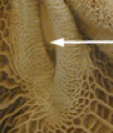
Esophageal groove of the wall of the reticulum sends liquid from the esophagus to the omasum. Disappears with age. Suckling triggers contraction to form groove. Bypasses the rumen. |
|
|
Mesentries |
In the thin sheets of the dorsal body wall that suspended organs in the abdomen that are extensions of the peritoneum |
|
|
Dudodenum |
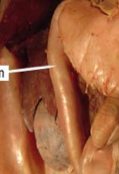
First segment of the small intestine. Recieves chyme from stomach, bile and pancreatic secretions empty here, gastroenteric reflex
|
|
|
Gastroenteric reflex |
Reflex in the duodenum where stretch and pH receptors in the duodenum inhibit gastric activity, decrease gastrin production, and decrease gastrin contractions. |
|
|
Ileum |
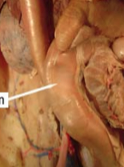
Last segment of the small intestine. Controls flow into the large intestine, and includes Peyer's patches.
|
|
|
Peyer's patches |
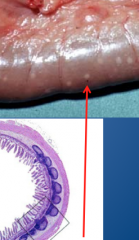
Patches of lymphoid tissue in the ileum. |
|
|
Small intestine motility |
Circular and longitudinal muscle layers including glands, nerves, and the vasculature in the submucosa. Peristalis and segmental contractions. |
|
|
Peristalis |
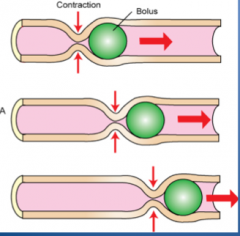
Type of small intestine motility that propels food bolus, ie squeezing a tube of toothpaste. |
|
|
Segmental contractions |
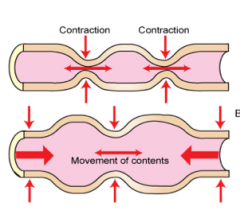
Type of small intestine motility that mixes contractions. |
|
|
Jejunum |
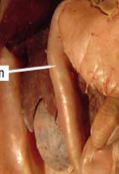
Second segment of the small intestine. The location for most of the chemical digestion and nutrient absorption. |
|
|
Brush boarders |

Microvilli on the surface of villi in the small intestine where all the digestive enzymes 'hang out'. |
|
|
Crypts |
Invaginations between villi in the small intestine where all new, intestinal epithelial cells are made. |
|
|
epithelial ; absorption ; diarrhea |
No intestinal _______ cells, no nutrient _________, = horrible ______ in Parvo |
|
|
Functions of the digestive system |
Prehension/ ingestion, mechanical processing including mastication(chewing) and physical motion along the digestive tract, chemical digestion, absorption of nutrients and water, and the elimination of wastes. |
|
|
Small intestine digestion and absorption |
Arranged in villi including arteries, veins, and lymph vessels that extend into the villi from submucosa, including brush borders and crypts. Nutrients intact across intestinal epithelium, and carbs and proteins are chemically digested first (diffusion or active transport) |
|
|
enzyme adaption |
Diet changes must be done slowly to allow ______ _______ . |
|
|
Enzymes; digesting |
_______ in lumen and associated with brush border do the ______ . |
|
|
Large intestine |
Absorb water and electrolytes from intestinal contents, store/form feces for elimination, some microbial digestion. Components include the cecum and colon (rectum) |
|
|
Hindgut fermentation
|
function of the large intestine in horses, guinea pigs, rabbits and rats where the colon and cecum function like rumen. |
|
|
Rectum |
Terminal portion of the large intestine. Mucus-secreting glands lubricate and aid in the passage of contents. Sensory receptors detect stretching and stimulates the defecation response. |
|
|
Anus |
Composed of internal (autotomic) and external (voluntary) muscular sphincters. As the rectum distends, stretch receptor in rectum wall causes partial relaxation of the internal sphincter. External opens with conscious effort. |
|
|
Liver |
Divided into right medial and lateral, left medial and lateral, caudate and quadrate. Supplied by portal vein and hepatic artery. Composed in hexagonal lobules. Includes the central vein in the middle, portal triad at the corners, and a plate of hepatocytes. Have Kupffer cells. |
|
|
Portal vein |
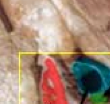
Vein in the liver where most of the blood comes from. |
|
|
Kupffer cells |
Found in the liver. Macrophages in the sinusoids that remove pathogens, cell debris, and damaged RBC's. Store extra iron absorbed by intestines. |
|
|
Portal triad at corners |
Parts of the hexagonal lobes in the liver that include the hepatic artery branch, portal vein branch, and bile duct branch. |
|
|
Plates at hepatocytes |
Parts of the hexagonal lobes in the liver that includes sinusoids between plates ( blood flow). They make bile, secrete albumin, and store carbohydrates |
|
|
Gallbladder |
Store bile made by hepatocytes that releases into the duodenum which is stimulated by CCK. Bile emulsifies fats by increasing the surface area of enzymatic actions and making lipids hydrophilic. |
|
|
Horses |
Animal that doesn't have a gallbladder. |
|
|
CCK (Choleycystokinin) |
From duodenum where chyme enters. |
|
|
Pancreas |
Organ that lies along the duodenum right lobe is the head, left lobe is the tail. Has endocrine and exocrine portions. |
|
|
Endocrine portion |

Portion of the pancreas where the cells in islets within the exocrine gland tissue. Has alpha and beta cells. |
|
|
Exocrine portion |
Secretes digestive enzymes into the lumen of duodenum including amylas (sugar), protease (protein) and lipase (lipids). Secretes biocarbonate to neutralize acid that comes from the stomach. |
|
|
Alpha cells |
Secretes glucagon to mobilize glucose out of cells for use. |
|
|
Beta cells |
Secrete insulin to move glucose into cells. |
|
|
Cats; Dogs |
Though both a taxonomically and anatomiclly carnivores, ____ are nutritionally carnivores whereas ___ are omnivores. |
|
|
36; 10; carbohydrate; metabolism |
Dogs have __ genomic differences from wolves, ____ are involved with _________ digestion and fat _______. |
|
|
Cats |
Need higher levels of proteins and fats. Must have Vitamin A, arachidonic acid and taurine in their diet. |
|
|
Factors nutritional requirements can be based on. |
Species, breeds, age, life stage, activity level, and reproductive status. |
|
|
Malnutrition |
Too little or too much. Not usually a problem when using commercial diets that are listed as 'complete and balanced' and are approved by the AAFCO |
|
|
Single food diets |
Non regulated diet that is not balanced, and can lead to too much of a single nutrient such as liver and vitamin A toxicity. |
|
|
Raw food diets |
Non regulated diet. ___ fish can contain thiaminase, and ___ meat can be contaminated. Ex. are Salmonella, Campylobacter, Toxoplasma gondii |
|
|
Less |
uncooked carbohydrates are _____ digestible. |
|
|
Improperly preserved diets |
Non regulated diet that leads to fat rancidity. |
|
|
Vegetarian diets for cats |
Non regulated diet to where animals require certain nutrients from animal tissue, and supplements are often too high in minerals |
|
|
Too many treats and/or table scraps |
Non regulated diet that is not balanced; has a greater chance for toxic food to be consumed. |
|
|
Classes of nutrients |
Water, vitamins, minerals, protein (animal energy), fat (animal energy) and carbohydrates (animal energy). |
|
|
Water |
The most important nutrients. Death within days of not having this. Need 44-66 mL per kG of body weight, though this may vary based on parameters. Can depend on how much food they consume. |
|
|
10; 75 |
Dry pet food is about ___% water, and canned pet food is about ____% water. |
|
|
Proteins |
Source of essential amino acids (taurine in cats), can make non-essential amino acids and body structures like muscle. Last resort energy source when catabolized. |
|
|
Taurine |
Protein that Can lead to central retinal atrophy and dilated cardiomyopathy in cats. |
|
|
Proteins |
Requirements vary with animal associated factors and with the quality and digestibility of it in the diet. |
|
|
Egg, organs and skeletal muscle and plants |
Highest to lowest in biological value |
|
|
Signs of protein deficiency |
Decreased growth rate, anemia, muscle atrophy, weight loss, dull and dry haircoat, decreased immune response and healing rates. |
|
|
Fat |
Excellent energy source (saturated fatty acids), make cell membranes and lipoproteins (unsaturated fatty acids), make cell communication molecules (prostaglandins and leukotrienes), absorb and transport fat soluble molecules (A, D, E and K). Some can't be made by the body . Need antioxidants to keep food from going rancid. |
|
|
Linoleic acid |
Essential fatty acid in corn and soy. Dogs can convert this into arachiodonic acid, but cats get this from their diet. Another essential(?) one is docosahexaenoic acid (DHA) |
|
|
Signs of fat deficiency |
Dull haircoat, dry flaky skin, underdeveloped testicles, anestrus, and decreased activity levels |
|
|
Carbohydrates |
categorized in 4 groups: absorbable (simple sugars like glucose, galactose and fructose), digestible (di- and oglio- saccharides), fermentable (lactose), and poorly fermentable (fiber, cellulose) |
|
|
Fiber and fermentable carbohydrates |
Help with "feces quality" and large intestinal motility, produce short chain fatty acids, and maintain beneficial intestinal bacteria. |
|
|
Dogs |
Get glucose from their diet either directly or from other carbohydrates. They digest them with glucokinase. |
|
|
Cats |
Can make glucose from amino acids and glycerol , but don't have to get it from their diet. They can digest carbohydrates, but use hexakinase instead of glucokinase. |
|
|
Vitamin A deficiency |
A vitamin deficiency that is associated with ocular problems. Cats need vitamin A in their diet, while others get it from beta-carotene. |
|
|
Hypervitaminosis A |
Vitamin deficiency from diets with too much liver. This can lead to skeletal problems. |
|
|
Vitamin D deficiency |
Vitamin deficiency that can lead to rickets. |
|
|
Hypervitaminosis D |
Vitamin deficiency that leads to soft tissue calcification |
|
|
Vitamin E deficiency |
Vitamin deficiency that leads to steatitis (yellow fat disease) and muscle deficiency |
|
|
Thiamine deficiency |
Vitamin deficiency occurring from cats being fed freshwater fish. Can lead to neurologic problems. |
|
|
Calcium and phosphorus deficiency |
Most common mineral deficiencies. These can lead to skeletal and muscle problems. Excess amounts can cause soft tissue mineralization. |
|
|
Soft tissue mineralization |
Mostly a problem in large and giant puppy breeds. Can lead to osteochrondosis and can decrease skeletal remodeling. |
|
|
Iron and copper deficiencies |
Mineral deficiency that is usually a problem in non-meat diets. |
|
|
Maintenance Energy Requirement |
Starting point of calculating energy requirements. The energy requirement of a moderately active animal in a thermoneutral environment. Begins by calculating the RER |
|
|
Highly |
Calculating energy requirements is ________ variable. |
|
|
RER |
Resting energy requirement. Energy needed by a healthy, fed animal at rest. Multiple by a factor to account for age, life stage, etc. (30 x body weight in kg) + 70 |
|
|
Look at slide 16 |
Nutrition |
|
|
Body conditioning system stage 1 for dogs |
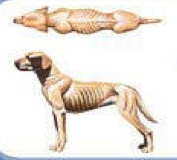
Ribs, lumbar vertebrae, pelvic bones and all bony prominences evident from a distance. No discernible body fat. Obvious loss of muscle mass. Too thin. |
|
|
Body condition system stage 2 for dogs |
Ribs, lumbar vertebrae and pelvic bones easily visible. No palpable fat. Some evidence of other bony prominence. Minimal loss of muscle mass. For dogs. Too thin. |
|
|
Body conditioning system stage 3 for dogs |
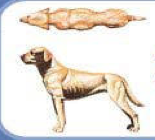
Ribs easily palpated and may be visible with no palpable fat. Tops of lumbar vertebrae visible. Pelvic bone becoming prominent. Obvious waist and abdominal tuck. Too thin. |
|
|
Body conditioning system stage 4 for dogs |
Ribs, easily palpable with minimal fat covering. Waist easily noted, viewed from above. Abdominal tuck evident. Ideal weight for dogs. |
|
|
Body conditioning system stage 5 for dogs |

Ribs palpable without excess fat covering. Waist observed behind ribs when viewed from above. Abdomen tucked up when viewed from side. Ideal weight. |
|
|
Body conditioning stage 6 for dogs |
Ribs palpable with slight excess fat covering. Waist is discernible viewed from above but is not prominent. Abdominal tuck apparent. Too heavy for dogs. |
|
|
Body conditioning stage 7 for dogs |

Ribs palpable with difficulty; heavy fat cover. Noticeable fat deposits over lumbar area and base of tail. Waist absent or barely visible. Abdominal tuck may be present. Too heavy. |
|
|
Body conditioning stage 8 for dogs |
Ribs not palpable under very heavy fat cover, or palpable only with significant pressure. Heavy fat deposits over lumbar area and base of tail. Waist absent. No abdominal tuck. Obvious abdominal distention may be present. Too heavy for dogs. |
|
|
Body conditioning stage 9 for dogs |
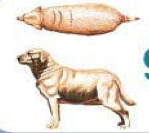
Massive fat deposits over thorax, spine and base of tail. Waist and abdominal tuck absent. Fat deposits on neck and limbs. Obvious abdominal distention. Too heavy. |
|
|
Body conditioning system stage 1 for cats |
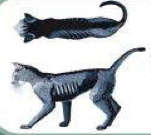
Ribs visible on shorthaired cats; no palpable fat; severe abdominal tuck; lumbar vertebrae and wings of ilia easily palpated. Too thin. |
|
|
Body conditioning system stage 2 for cats |
Ribs easily visible on shorthaired cats; lumbar vertebrae obvious with minimal muscle mass; pronounced abdominal tuck; no palpable fat. Too thin in cats. |
|
|
Body conditioning system stage 3 for cats |
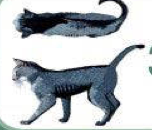
Ribs easily palpable with minimal fat covering; lumbar vertebrae obvious; obvious waist behind ribs; minimal abdominal fat. Too thin |
|
|
Body conditioning system stage 4 for cats |
Ribs palpable with minimal fat covering; noticeable waist behind ribs; slight abdominal tuck; abdominal fat pad absent. Too thin for cats. |
|
|
Body conditioning system stage 5 for cats |
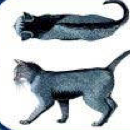
Well proportioned; observe waist behind ribs; ribs palpable with slight fat covering; abdominal fat pad minimal. Ideal. |
|
|
Body conditioning system stage 6 for cats |
Ribs palpable with slight excess fat covering; waist and abdominal fat pad distinguishable but not obvious; abdominal tuck absent. Too heavy for cats. |
|
|
Body conditioning system stage 7 for cats |
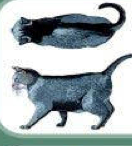
Ribs not easily palpated with moderate fat covering; waist poorly discernible; obvious rounding for abdomen; moderate abdominal fat bad. Too heavy. |
|
|
Body conditioning system stage 8 for cats |
Ribs not palpable with excess fat covering; waist absent; obvious rounding of abdomen with prominent abdominal fat pad; fat deposits present over lumbar area. Too thin for cats. |
|
|
Body conditioning system stage 9 for cats |
Ribs not palpable under heavy fat cover; heavy fat deposits over lumbar area, face and limbs; distention of abdomen with no waist; extensive abdominal fat deposits. |
|
|
Avocado |
Common food hazard in horses, ruminants, rabbits, guinea pigs, rodents and birds. Dogs and cats are resistant. Myocardial necrosis, sterile mastitis, and symptoms between 24-48 hours. Can be fatal. Toxic principle = person. |
|
|
Macadamia nuts |
common food hazard in dogs. Non fatal, and the symptoms occur within 12 hours. They include weakness, vomiting, ataxia, hyperthermia. |
|
|
Raw bread dough |
Common food hazard in dogs. Most animals don't try to eat this. Continues to grow in stomach and continues to expand. Gastric distension with compromised vasculature. Alcohol from blood can cause alcohol toxicosis. (metabolic acidosis, respiratory depression, ataxia) |
|
|
Raisin and grapes |
Common food hazard in dogs, some reports in cats and ferrets. Anuric renal failure in 6-12 hours of ingestion. Toxic mechanism is not known, but it causes damage to renal tubular epithelium. |
|
|
Onions and garlic |
Common food hazard in dogs. Toxic principle is thiosulfate, and symptoms occur days after infection. can lead to hemolytic anemia. |
|
|
Hemolytic anemia |
Vomiting, diarrhea, dark yellow- red urine, possible icterus, labored breathing. |
|
|
onions |
All forms of ______ are toxic. They are more toxic than garlic. |
|
|
Chocolate |
Common food hazards in dogs and cats. Toxic principle = thobromine. It metabolizes more slowly than in humans. Has vomiting, diarrhea, tremors, cardiac arrythmias, seizures. Can be fatal |
|
|
Xylitol |
Common food hazard in dogs. Common in gum. Causes rapid release of large amounts of insulin. Can lead to hypoglycemia. Can lead to liver failure. Timing of symptoms varies with product ingested. 30 minutes = 12-18 hours |
|
|
Hypoglycemia |
Weakness, ataxia, seizures, coma, hypokalemia. From xylitol |
|
|
Liver failure |
Vomiting, icterus, problems with blood clotting mechanisms. From xylitol |

